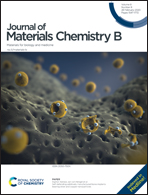VE-cadherin fusion protein substrate enhanced the vasculogenic mimicry capability of hepatocellular carcinoma cells
Abstract
To investigate the VE-cadherin-based intercellular crosstalk in tumor cells, a fusion protein consisting of a human VE-cadherin extracellular domain and an immunoglobulin G Fc region (hVE-cad-Fc) was prepared as an artificial extracellular matrix (ECM) for the culture of hepatocellular carcinoma cells (Bel7402 cells). Compared with cells cultured on TCPS and collagen coated plates, the Bel7402 cells cultured on a series concentration of hVE-cad-Fc coated plates showed elongated morphology, inhibited proliferation, and significantly enhanced migration and secretion of ECM compounds and cytokines in a concentration-dependent manner. When the concentration of hVE-cad-Fc reached 15 μg mL−1, the Bel7402 cells formed a patterned network with positive-staining of PAS. The high-density hVE-cad-Fc substrate markedly elevated the expression of endogenous VE-cadherin and EphA2, and subsequently activated the intracellular signal transduction pathways including VE-cadherin/PI3K/MMPs and VE-cadherin/EphA2/FAK/p-VE-cadherin axes as well as epithelial–mesenchymal transition (EMT). Therefore, the high-density hVE-cad-Fc substrate was able to induce the vasculogenic mimicry (VM) formation of Bel7402 cells, and exhibit the potential for the construction of an in vitro tumor model of VM. Moreover, hVE-cad-Fc appeared to be a promising candidate for the investigation of VE-cadherin mediated cell–cell interactions in tumor development.



 Please wait while we load your content...
Please wait while we load your content...